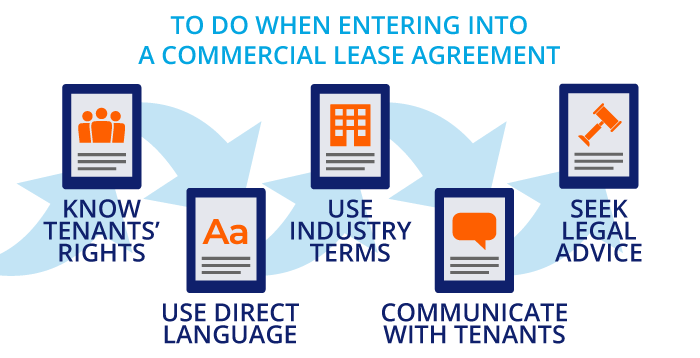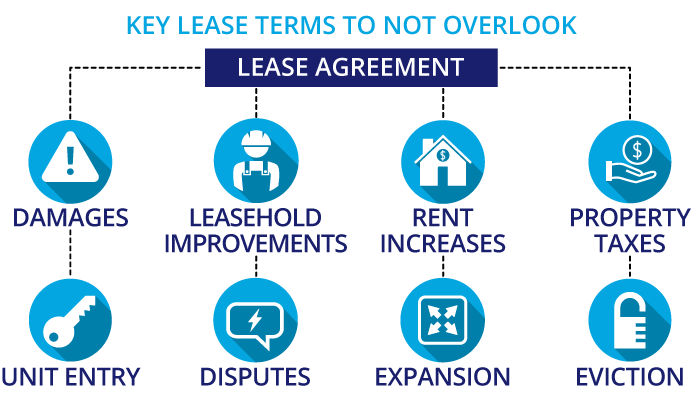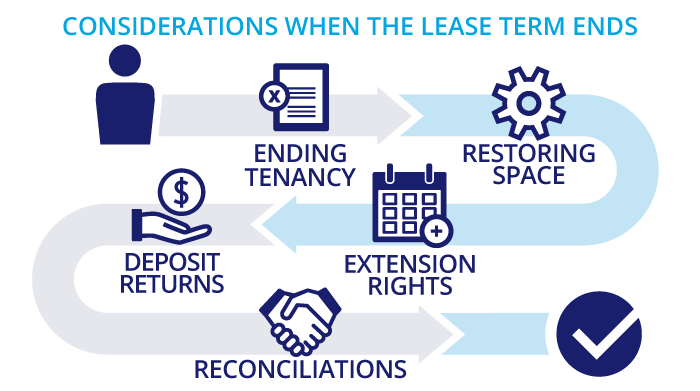Commercial Tenant Rights: An Overview
As a landlord, it is important to understand commercial tenant rights as well as your rights and obligations. Commercial tenancy regulations are far less restrictive than residential landlord-tenant acts and tend to favour the landlords. This is because commercial lease agreements are viewed as contracts between knowledgeable business people. Therefore, the assumption is that they are capable of negotiating lease terms that benefit both parties. As a result, commercial lease parties tend to use more of their negotiating ability than those of a residential lease.
While every country, state and province has its own regulations to oversee these agreements, all tend to lean heavily on the wording of the lease agreements as “law” that guides the relationship.
It is essential to make sure the lease language is as straightforward as possible and clearly outlines the tenant’s responsibilities. But a word of caution. Veering away from industry language is not recommended. Inexperienced parties tend to write their agreements only in terms of intent (rights). While this seems helpful, most of the lease language is used to delineate boundary conditions of expected behaviour (responsibilities) and contains terms and remedies to describe the processes that will be used if a breach occurs. Industry terms have been tested for interpretation in the courts, and insurance companies rely on those definitions to underwrite their insurance risks.
Lease terms have meaning in a legal context, and the lease is a legal agreement. If it is not possible to write the lease in easy-to-understand terms, provide a summary of rights and obligations in clear language to outline your expectations. Commercial tenants need time to review and receive legal counsel on the lease agreement language, terms and clauses. Both parties should understand the lease terms and be aware of rights and responsibilities.

Prior to signing the lease
The best way to make sure both parties are aware of their responsibilities is to communicate openly. Clear lines of communication will ensure fewer misunderstandings and help build a stronger relationship and a level of trust. A good relationship foundation helps when questions or complex issues need to be discussed.
Before you enter into a commercial lease agreement, it’s essential to seek legal advice. Doing so will help you determine which specific policies apply to your situation. While there are laws and regulations in each jurisdiction, a signed lease agreement can waive rights granted in the acts. A good lease will outline each party’s obligations, including those relating to leasehold agreements, operating and maintenance costs, and rent, among others.
What should a commercial lease include?
A lease is a contract that outlines the rental rights and responsibilities of both the landlord and tenant. This document is intended to provide clear guidelines to both parties to minimize any potential misunderstandings.
While every lease is different, and there is no one-size-fits-all template, it should include certain items:
- Names of lessor and lessee (landlord and tenant)
- Rent amounts and rent frequency
- Insurance requirements
- The length of the lease and type of tenancy (fixed-term or month-to-month)
- Conditions for terminating or extending the lease
- Ownership of any leasehold improvements
- Responsibilities for repairs and maintenance
- Shared space and amenity cost allocations
- Consequences of non-payment of rent and other expenses
- Specifics of when/how a security/damage deposit is considered forfeited or partially refunded
- Permitted uses of premises
- Ownership of fixtures
- Liabilities and force majeure
- Any other details that have been negotiated between the landlord and the tenant
The lease terms should clearly outline whether it is a gross lease, net lease, triple net lease or percentage net lease.
If the tenant needs to alter the space before moving in, get the leasehold improvement details in writing first. The lease should outline who pays for what and whether there are any restrictions on what they can do. This will help avoid any disputes over financing and the scope of the project. The lease should also outline who is responsible for obtaining regulatory approvals and permits. Also, the lease should detail what the landlord requires from the tenant to approve the tenant’s scope of work. For example, details could include engineered drawings, work reviews and the conditions for releasing the tenant improvement allowance.
Remember, a commercial lease is a binding contract between the landlord and tenant, so the terms should be agreeable to both parties. Both the landlord and the tenant must sign the lease to formalize the business relationship. Doing so will protect not only commercial tenant rights but also the landlord’s rights as well.
During the lease term

Damages and breakdowns
Though not common in commercial leasing, you and your tenant may wish to complete an inspection report before taking possession of the property. This form contains a description of the property to detail the unit’s condition at the time of move-in. This document can support claims for the repair of damages as they occur. More commonly, the premises come “as is.” The tenant makes their leasehold improvements before occupancy, which the landlord inspects before releasing the Tenant Improvement Allowance (TIA). These improvements usually negate the usefulness of an inspection report completed at the time of possession.
Savvy tenants ask the landlord to guarantee the existing building systems (i.e. doors, dock systems, electrical services and HVAC units) for three months or, for HVAC units, three months into the first season of use.
Leasehold improvements
Tenants may require changes to the unit to make it functional for their specific purposes. These requirements should be worked into the lease in advance and clearly state which party will retain ownership of the improvements. Most commercial net leases assign ownership of the leasehold improvements to the landlord, but the tenant must still insure and maintain them. There are several ways that payment can be handled for these improvements. Further details on leasehold improvements can be found here.
Rent increases
The lease agreement should detail any increases to the rent. The landlord must include specific policies regarding rent increases to ensure that tenants know the terms and conditions. The lease alone serves as the full and final notice of all rents due. Leases almost always specifically exempt the landlord from any requirement to provide prior notice of any rental amounts being due.
Paying property taxes
This is a provision that must be outlined in the lease before tenancy. If the landlord expects the tenant to pay property-related taxes in part or in full, this must be included in the lease agreement. The clauses must be worded so that the tenant is not on the hook for future taxes once they have terminated their tenancy.
Entry to the rental unit
The lease terms determine the landlord’s rights to premises access. For example, the lease can specify access to both keys and access codes and entry without any notice or lessor rights.
Settling disputes
If the landlord is not fulfilling their obligations, the tenant has the right to take the landlord to court to force them to comply with the conditions of the lease agreement. Additionally, the tenant can ask for compensation for any losses related to the landlord’s negligence.
When a tenant has breached the lease, the landlord must notify them in writing and provide a reasonable amount of time—usually 10 days—for them to begin to comply. If the tenant has failed to fulfill their obligations, the landlord has the right to terminate the tenancy. They can also take the tenant to court to reclaim any rental income owed as a result.
Expansion rights
If a unit opens up in the commercial property, an existing tenant within the building may have the right to lease it before anyone else. This is the Right of First Opportunity, or ROFO. If a tenant is looking to expand their presence within that building, this can give them an advantage in a competitive market. This does guarantee that the tenant will secure the space, however. The ROFO usually specifies the rent terms, often 90% to 100% of the market rate.
The Right of First Refusal (ROFR) works a little differently. The landlord is entitled to lease the available space to a third party, but first, the existing tenant has the right to match the third-party’s offer on the unit. In this case, the tenant does not have the opportunity to negotiate the lease terms with the landlord; they must accept or decline the terms presented.
In either case, the ROFO or ROFR details should be very clearly spelled out in the lease agreement ahead of time so that both parties know their rights. You can find more information on ROFO and ROFR clauses here.
Eviction
Landlords can evict tenants for not following the lease terms. That’s why it’s critical to be aware of all the obligations set out in the lease to maintain compliance.
If tenants do not pay their rent on time, the landlord has two primary courses of action.
The first is to terminate the lease and evict the tenant. This typically happens after a set amount of time without rent payments. The landlord changes the rental unit’s locks. Ideally, this occurs after giving the tenant reasonable time and access to remove property from inside the unit. However, this ends the landlord’s right to use other options he has under the lease. Typically, this isn’t the first choice as commercial leases are valuable, and the recovery rights are significant.
The second is known as the right to distrain the tenant’s chattels. Typically the tenant’s chattels are the lifeblood of their operations, and their business is finished without them. This provides significant motivation for the tenant to redeem the lease. The landlord seizes the tenant’s property on the premises. The landlord must give the tenant notice of the seizure and hold the property for five days before disposal. If the back rent is still unpaid, the landlord is free to sell the seized property to recoup some of their losses. If the value of the tenant’s property exceeds the back rent, the excess must be paid back to the tenant.
The landlord has various rights outlined in the lease, which can be jointly or severally applied. For example, the landlord can apply a three-month rent penalty in addition to seizing the tenant’s property. On the other hand, the right to distrain can be specifically excluded in the lease terms. This is more common for tenants with a patented or restricted product.
At the end of the lease term

Ending a tenancy
Most regulatory bodies have rules about how a lease can be ended. In a month-to-month tenancy, either the tenant or the landlord must give written notice at least one month in advance of termination. For a fixed-term lease, there is no requirement to provide notice to terminate by the end date. If both parties wish to continue the lease agreement, a lease extension agreement should be made before the due date. Without an amended lease agreement, the tenant becomes a month-to-month tenancy in an overholding position and no longer has the right to occupy the unit once the term is up. Overholding usually comes with a rental rate increase to compensate the landlord for the term insecurity.
Restoration of space
If the tenant has made significant changes to the unit through leasehold improvements, the landlord may require them to restore the premises to the original condition. Landlords may wait until close to the end of the lease term to make that decision, as some alterations may enhance the space and increase the property’s value. However, tenants need to know whether they need to outlay a considerable expense at the end of their lease and budget accordingly. Optimally, if the landlord granted approvals before the leasehold improvements, they should add the restoration clauses to the lease in advance to avoid last-minute panic.
Extension rights
When continuing a tenancy, there can be two options: renewal or extension. A renewal of a lease agreement constitutes a wholly new agreement, potentially with new terms and obligations. An extension, however, continues the existing lease agreement with the landlord with an extended end date. The renewal represents a short break (and potential change) in the relationship between the two parties. The extension perpetuates the original lease without a gap. An extension is preferred when both the landlord and the tenant are happy with the existing conditions and wish to continue the relationship as is.
Security deposit returns
At the end of the tenancy, the landlord must return the initial security deposit, less any charges for damages incurred. The landlord will often require the tenant to vacate the premises first to inspect the unit. If any damages are found, the landlord should provide documentation as proof of the damage and itemize any deductions taken from the security deposit. The tenant may negotiate these deductions if they can show evidence that the damage was pre-existing or occurred due to normal wear and tear. If no significant damage occurred during the lease term, the deposit should be refunded. Tenants who have proved themselves to be reliable and trustworthy may be able to negotiate the early return of the deposit, but that would be on a case-by-case basis.
Final reconciliations
Both parties should agree upon any further reconciliations as outlined in the lease. Any reconciliations that occur outside of the parameters of the lease should be negotiated by the two. In the event of a disagreement, the parties can settle the issues in court.
These are just some of the general commercial tenant rights and landlord rights that you may come across. Some of this information may vary from country to country, state to state and province to province. As usual, always consult a commercial property lawyer before entering into a lease agreement, and seek legal advice to ascertain your specific rights in the event of a dispute.
Disclaimer
This article is for informational purposes only and is not intended as professional advice; please consult a competent professional for advice specific to you. This blog is written to stimulate thinking on concepts related to commercial leasing. Please join the discussion with your experiences.

Martin Sommer, CEO, CRESS Inc.
Martin is a founder and the CEO of CRESS Inc., a Canadian SaaS company that automates lease administration and asset management. Martin also manages Karanda Properties Limited industrial portfolio as Director of Operations in all areas of commercial property management, including new development, asset management, capital expenditures, operations, leasing and lease administration of the industrial portfolio. Martin writes about property management workflow and issues. Book Martin to speak at your industry event.





